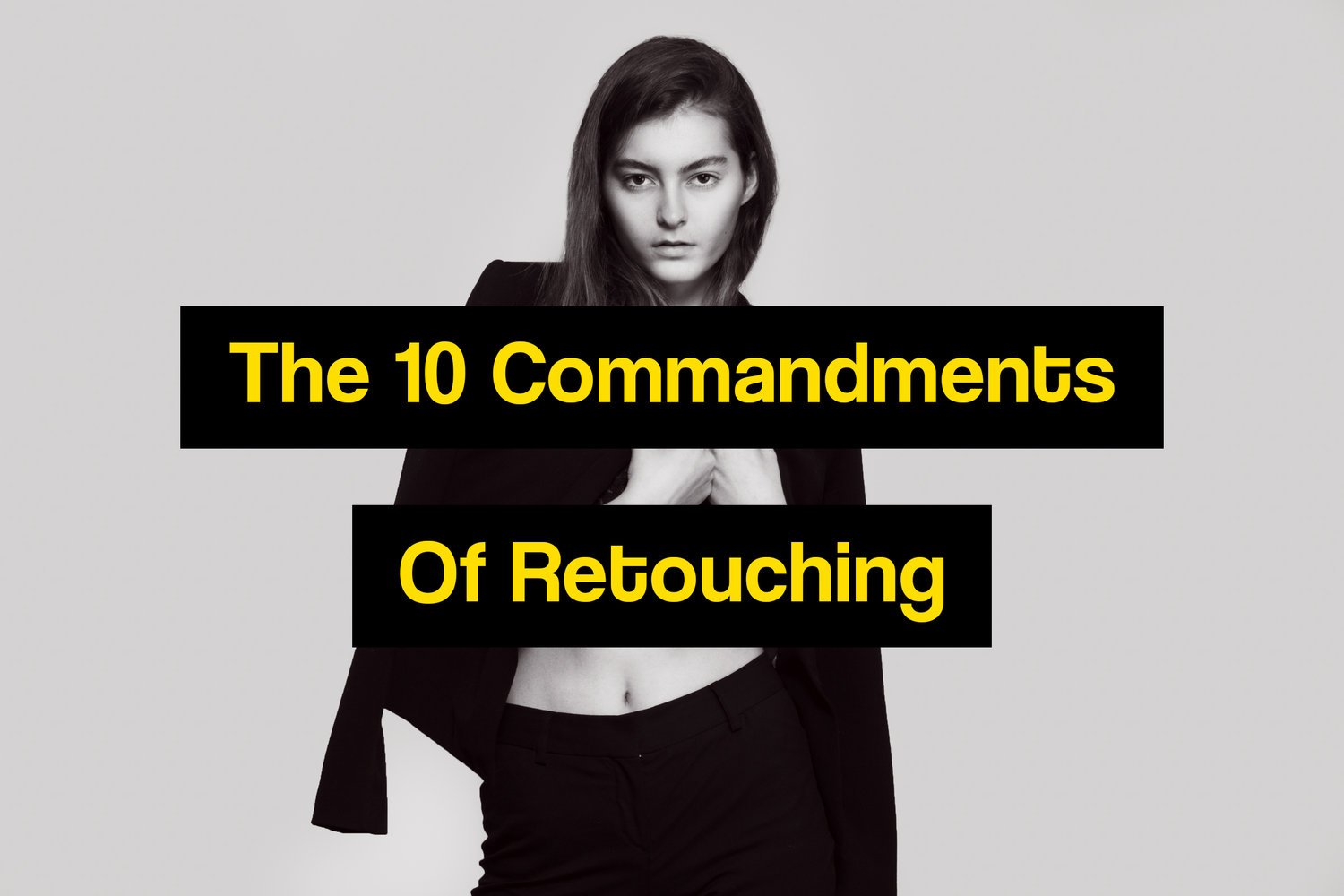
![]()
There are some things in life that are universal rules we should all follow—things like not cheating on your wife, not killing anyone, and not stealing. Easy enough, right? And if life has Ten Commandments that are just obvious things not to do, retouching should have them as well.
Here’s are my 10 Commandments of Retouching.
I. Thou Shalt Not Blur Thy Skin
![]()
This is just a poor retouching technique. When you’re just starting out, it’s understandable. But as you progress and start doing more, you should either hire a retoucher for all of your shoots or learn the proper techniques.
If you want to learn the proper techniques yourself, this was the single biggest resource that helped me learn more.
II. Thou Shalt Not Edit on a Single Layer
![]()
Destructive editing isn’t good. It makes it tougher when you make a mistake and need to go back. It’s like doing a crossword puzzle in pen—sure, it’s doable, but that doesn’t mean you should. And it doesn’t make you look cool.
Editing over every layer makes it tougher in the moment, but being able to isolate different editing portions allows you to stay organized when you go back and need to fix things. It’s tough to get into a habit of doing. I sometimes forget to accidentally open a new layer for edits, but it’s something that makes for better, and more organized retouching.
III. Thou Shalt Not Brighten the Whites of the Eyes
![]()
There’s the right way to edit eyes, and there’s the wrong way. The right way: Stay within the pupils and just bring out the color a bit. The wrong way: Brighten everything inside the eyelids.
If you want to read about more natural ways to retouch eyes, here’s a great read on understanding eyes and how to retouch them.
IV. Thou Shalt Calibrate Thy Monitor Every Few Months
![]()
Monitors are fickle. The more they’re on, the more they’re being used, the color on them is like to change.
Depending on how often you use your monitor, you can be seeing much different colors from the last time you calibrated (if you ever did). That’s why calibration systems ask you to calibrate every month-few months. It’s just one of those things you have to do like going to the dentist every 6 months.
V. Thou Shalt Respect Thy Subject’s Body Type
![]()
If a woman is a size 9, don’t make her a size 2. Easy as that. It’s one thing if you’re shooting fashion and the dresses that day are a little too tight. It’s another thing when you make their butt and breasts expand like the Grinch’s heart on Christmas day.
VI. Thou Shalt Leave Smooth Transitions From Highlights to Shadows
![]()
Light falls on the face a certain way. Sure there’s a difference between softbox and beauty dish fall off, but the transitions aren’t supposed to be incredibly sharp. They have a gradation to them. When you’re dodging and burning, you should try and keep as much of the natural gradation that you can.
Obviously, this goes for more natural retouching and not art pieces where you’re going for that look.
VII. Thou Shalt Edit Each Photo in a Series Consistently
![]()
If you look at 2 images from the same set, are they the same brightness exactly? Are the same blemishes removed? Does the background have the same look/color in them?
Consistency from photo to photo is a learned skill, but it is probably one of the most important skills. If you bought 2 chairs from Ikea, you’d want them to be exactly the same. You wouldn’t want one to be slightly darker and have 1 leg that’s shorter than the rest.
VIII. Thou Shalt Not Be A Cheapskate, or: Actually Purchase The Adobe Creative Cloud Suite
![]()
$10 a month. Come on. If you use free alternatives that’s fine, but there’s no reason to steal Photoshop or Lightroom. And if you’re a college student, you can get the Photography Plan or the full plan for even cheaper.
IX. Thou Shalt Not Overuse the Sharpening Tool
![]()
It’s like you’re cooking. If you do a taste test and find it needs a little salt, you don’t just dump salt on the entire meal… you add a pinch. A little goes a long way. Here’s a good little guide on how to sharpen better. And if your image is just really blurry, there’s not all that much you can do to fix this.
X. Thou Shalt Not Wait To Fix In Post
Hair on the model’s shoulder? Don’t just wait to fix that in post. If it’s something you can physically fix in the moment, do it. You shouldn’t wait until you’re home and realize you’re not as good as you think you are. Retouching is an art form and should be respected, just like photography. You can’t just take a photo any situation and make it perfect. Some things are un-fixable.
Unfortunately I don’t have a link to getting better at this. You just need to pay more attention during the shoot. Always try to be paying attention to certain details while shooting.
Where is the hair falling on the model? Is anything out of place? Is their shirt tidy? Just some things I like to try and think about during shoots.
About the author: David Justice is a portrait, fashion, and beauty photographer based in New Britain, Connecticut. The opinions in this article are solely those of its author. To see more of David’s work, visit his website or follow him on Instagram. This article was also published here.

